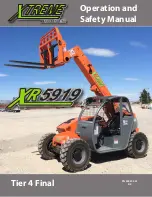
Conduct preoperational inspection every day, and voluntary inspection periodically once a month.
Parts subject to inspection
Description of inspection
1. Inspection to be conducted with the key switch turned OFF
(1)
[1]
[2] Mast
[3] Fork
[4] Tire
[5] Main bolt/nut
(2)
(3) Battery
2. Inspection to be conducted with the key switch turned ON
(1) Charge level
(2)
[1]
[2]
(3)
[1]
[2]
(4)
[1] Horn
3. Inspection to be conducted while traveling slowly
(1)
[1]
Turn the traveling knob toward the operator to travel forward.
While traveling, lower the handle to make sure that the forklift stops.
Speed change
[2]
Turn the traveling knob toward the vehicle body to travel backward.
While traveling, lower the handle to make sure that the forklift stops.
(2) Handle
Check for play and looseness of the handle.
(3) Safety device
[1]
[2]
Press the emergency stop button to make sure that all operations stop.
(4) Abnormal sound
Check for abnormal sound during operation of each part.
The above inspections should be conducted with the forklift placed on a flat place under no load (without cargo).
If abnormality is found, repair the relevant part immediately.
Hydraulic unit
Maintenance
: If the battery electrolyte volume is insufficient,
replenish purified water.
Cylinder and piping
Battery electrolyte volume
Fork operating device
Tilt operating device
Battery discharge meter
Raising the fork
Lowering the fork
Tiling the mast backward
Setting the mast vertical
Safety device
Maintenance
: If the battery charge level is insufficient, charge the battery.
Press the horn button to make sure that the horn sounds.
Turning the switch toward the front resets the mast to the vertical form.
46
Turning the switch toward the operator tilts the mast backward.
Turning the switch toward the front lowers the fork.
Turning the switch toward the operator raises the fork.
Check for damage or abnormal wear of each tire.
Check for damage of the mast.
Check for looseness and damage of the fork.
Check for looseness.
Check for oil leak from the cylinder and piping.
Check the battery electrolyte volume.
Check the battery charge level.
Be sure to conduct preoperational inspection every day before start of work. Details of preoperational inspection
are as follows:
Appearance of
vehicle body
Exterior of vehicle body
Check for dent, warpage or crack of the vehicle body.
Check for oil drip under the vehicle body. (Oil leak check)
Traveling and
braking
Forward traveling and
braking
Backward traveling
and braking
Emergency stop button
Pinch accident
prevention switch
Press the pinch accident prevention switch to make sure that the
forklift travels backward.
Run the forklift again, and set the handle vertical to make sure
that the forklift stops.
While traveling, press the speed change switch to make sure
that the traveling speed changes to the low speed mode.
Run the forklift again, and set the handle vertical to make sure
that the forklift stops.
5. Inspection and Maintenance
Preoperational inspection
































